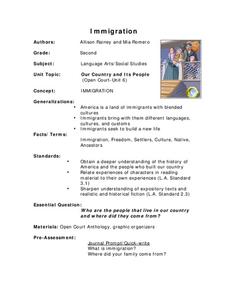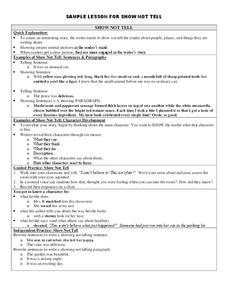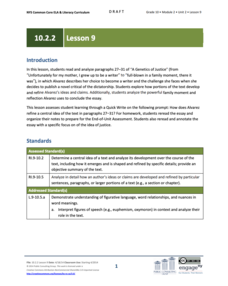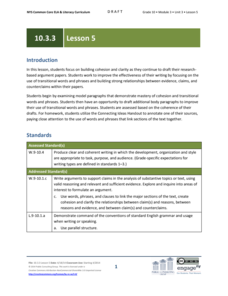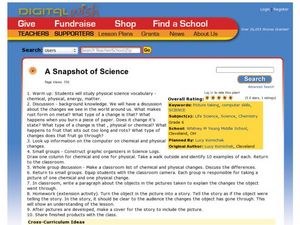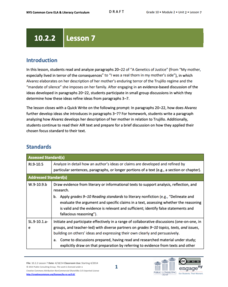Ohio State University
Lesson Plan on China
Scholars ponder the beliefs of Confucianism. After reading several sayings made by Confucius, participants complete a chart filling in what each saying means using their own words. Using the same quotes split in half, pairs match...
Curated OER
Main Idea in Informational Text
Individuals complete a pre-assessment to gauge their ability to determine the main idea and supporting details in nonfiction text. They examine a new piece of nonfiction reading by looking at the table of contents, headings, and index...
ReadWriteThink
Compare and Contrast
Read about the ways that different cultures set up homes with a set of reading activities. Learners read short paragraphs that cover one or more different ideas, and answer four questions about what they have read, including whether or...
Curated OER
Immigration
Second graders read about immigration from their text. They select one culture and identify characteristics of the group. Students complete a graphic organizer (included with the lesson). They recall and list various aspects of their...
K5 Learning
Sharks
"Dun dun... dun dun." A shark! After second graders read a four-paragraph passage about sharks, they respond to four reading comprehension questions that use the text as a basis for the answers.
Curated OER
Getting to Know Characters
This set of worksheets constitutes enough work and materials to be considered a lesson. They guide readers through a process of exploring characters and their motivations, and writing a paragraph about them. Here are seven handouts that...
EngageNY
Grade 10 ELA Module 2: Unit 2, Lesson 4
What does it mean to come undone? Scholars consider the author's use of the phrase as they read paragraphs 12–15 from Julia Alvarez's autobiographical essay "A Genetics of Justice." They complete a quick write to analyze how Alvarez...
Curated OER
Show Not Tell
Middle schoolers learn to show, not tell, in their narrative writing. A slide show takes them through the process of choosing strong, descriptive words, and then provides writing prompts for them to use as practice. The first two pages...
EngageNY
Grade 9 ELA Module 3, Unit 3, Lesson 1
The opening exercise in this instructional unit introduces class members to the writing process they will follow to craft an informative, expository research paper that addresses their research question. To begin, writers are asked to...
Curated OER
Child Safety
Explore reading comprehension and child safety in this young adult literacy lesson plan. High schoolers practice using context clues to figure out word meanings after observing a teacher model this process. They read an article about...
EngageNY
Grade 10 ELA Module 2: Unit 2, Lesson 9
How do authors develop the main ideas in their writing? Pupils consider the question as they read and analyze paragraphs 27–31 from Julia Alvarez's essay "A Genetics of Justice," in which Alvarez describes her decision to become a...
EngageNY
Grade 10 ELA Module 3: Unit 3, Lesson 5
Can you please clarify? Scholars continue to work on their argumentative essays about selling human tissue by clarifying and adding cohesion. Writers begin by looking at model paragraphs and then begin improving their writing. They...
EngageNY
Mid-Unit Assessment and Establishing a Context for My Hero’s Journey Narrative
How do writers engage their readers in a story? Pupils consider the question and use the informational text, "The Hero's Journey" to justify their plan for their own fictional narrative. To that end, scholars write an explanatory...
K20 LEARN
Lord of the Flies Unit, Lesson 8: In The End
To end the unit, groups use the Honeycomb Harvest strategy to show connections among a character, symbols, and themes in the novel and then create an Anchor Chart for the character that includes a symbol that best represents him. They...
Facing History and Ourselves
The Audacity of a Vote: Susan B. Anthony’s Arrest
Susan B. Anthony's speech "Is It a Crime for Women to Vote?" takes center stage in a lesson that asks class members to consider how they might respond to what they consider an unjust law. Groups work through the speech paragraph by...
Curated OER
A Snapshot of Science
Sixth graders explore physical and chemical changes. In this physical science lesson, 6th graders study vocabulary, discuss the changes they see in the world and look up information on chemical and physical changes. Students create...
Curated OER
Sounding Smart!
A list of vocabulary terms relating to the cell membrane tops this page. Biology learners show what they know by using the words to write a paragraph about cell membrane structure and function. Consider using this as a quiz or part of a...
San Francisco Symphony
Admirable Armonica Admirers
What do Ben Franklin and Wolfgang Mozart have in common? Find out about the musical invention, the armonica or glassy-chord. Learners will read about how Ben Franklin invented this new instrument and how Wolfgang Mozart came to play it....
EngageNY
Grade 9 ELA Module 3, Unit 3, Lesson 4
The fourth activity in a unit on crafting a research paper focuses on cohesion within and between paragraphs. Class members examine models that lack cohesion and ones that are cohesive and logically developed before using what they have...
EngageNY
Grade 10 ELA Module 2: Unit 2, Lesson 3
Does trauma have a lasting effect on people's lives? Scholars dive into the topic as they read paragraphs 9–11 of "A Genetics of Justice" by Julia Alvarez, in which the author describes her family's return to the Dominican Republic....
EngageNY
Grade 10 ELA Module 2: Unit 2, Lesson 7
"No flies fly into a closed mouth." Pupils consider the proverb's meaning as they read paragraphs 20–22 from the essay "A Genetics of Justice" by Julia Alvarez. They also engage in small-group discussions about how the author refines her...
EngageNY
Grade 10 ELA Module 2: Unit 2, Lesson 8
How do people's relationships with their parents impact their lives? Scholars read paragraphs 23–26 from "A Genetics of Justice" by Julia Alvarez, in which the author details her relationship with her mother. Pupils discuss how the...
Fluence Learning
Writing About Literature: Comparing and Contrasting Characters in Heidi
Scholars read excerpts from the story, Heidi, in a three-part assessment that focuses on comparing and contrasting characters. Each part contains three tasks that challenge learners to discuss, answer comprehension questions,...
K12 Reader
Converting Energy to Motion
Combine science and reading skills with a reading comprehension exercise. Kids read four paragraphs about energy conversion and answer some reading comprehension questions about the information they have read.
Other popular searches
- Paragraph Writing
- Five Paragraph Essay Writing
- 5 Paragraph Essay Writing
- Persuasive Paragraph Writing
- Example Paragraph Writing
- Hamburger Paragraph Writing
- Esl Paragraph Writing
- Narrative Paragraph Writing
- Paragraph Writing Dialogue
- Essay Writing 5 Paragraphs
- Five Paragraph Writing
- English Paragraph Writing





